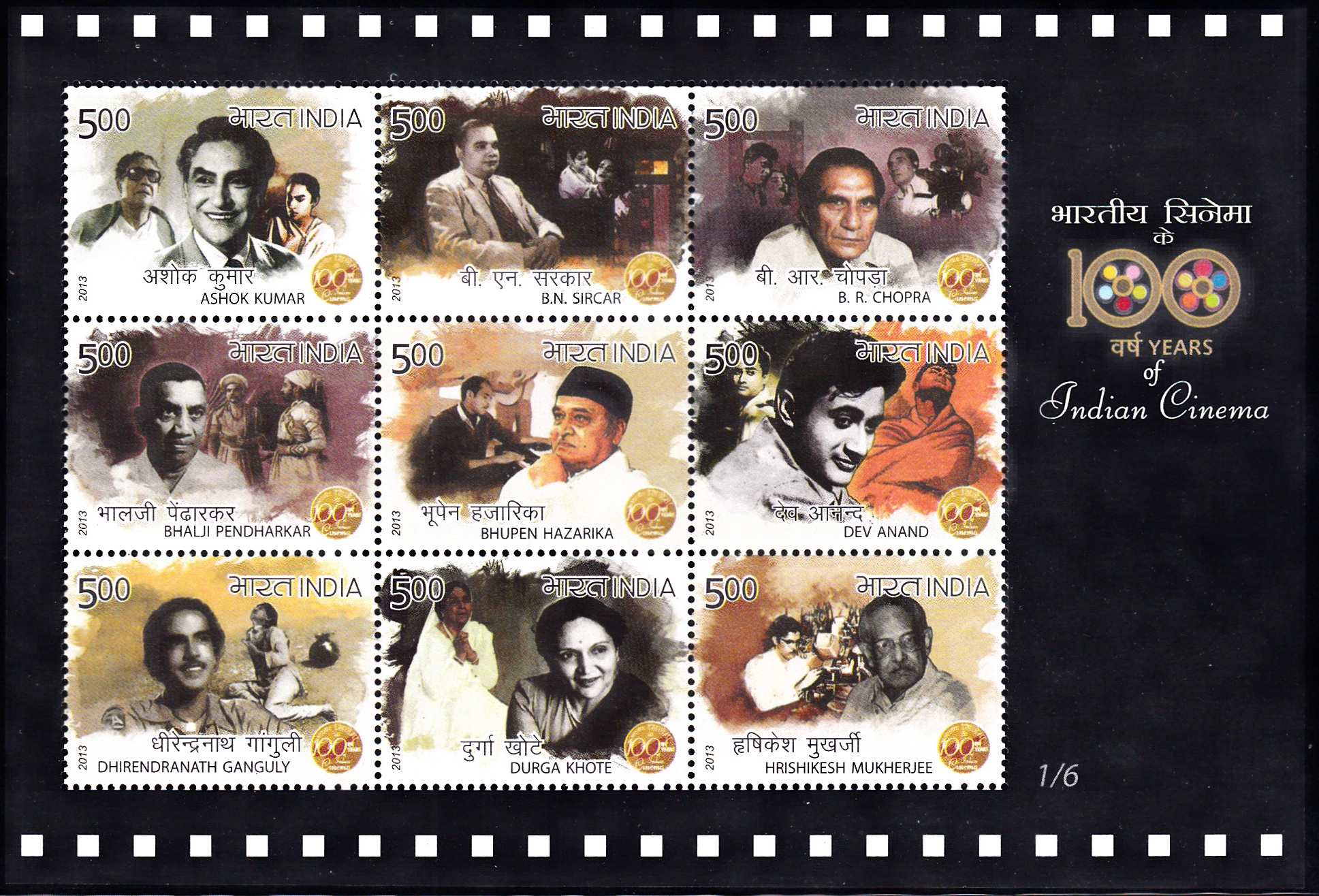
100 Years of Indian Cinema
6 Miniature Sheets consisting of 50 nos. of commemorative postage stamps on the Centenary of the Indian Film Industry :
Issued by India
Issued on May 3, 2013
Issued for : Nothing captures the essence of popular culture in present day India better than their films. Department of Posts is happy to be a part of the century-long journey of Indian cinema by releasing six Miniature Sheets commemorating the contribution of fifty iconic personalities of Indian Cinema. The first two Miniature Sheets with nine stamps each depict some Dada Saheb Phalke awardees whereas rest with eight stamps each depict the personalities from various fields of cinema.
Design : First two Miniature Sheets (9 x 2) – Some Dada Saheb Phalke awardees : [Ashok Kumar, B. N. Sircar, B. R. Chopra, Bhalji Pendharkar, Bhupen Hazarika, Dev Anand, Dhirendranath Ganguly, Durga Khote & Hrishikesh Mukherjee], [Majrooh Sultanpuri, Naushad, Nitin Bose, Prithviraj Kapoor, Raichand Boral, Ruby Myers, Sohrab Modi, Tapan Sinha & Yash Chopra].
Last four Miniature Sheets (8 x 4) – Some Personalities from various fields of Cinema : [Allu Ramalingiah, Ashok Mehta, Balraj Sahni, Bhanumathi, C. V. Sridhar, Chetan Anand, Kamaal Amrohi & Geeta Dutt], [Kannadasan, Madan Mohan, Mehmood, Motilal, Nagesh, O. P. Nayyar, Prem Nazir & R. D. Burman], [Raj Khosla, Rajendra Kumar, Rajesh Khanna, S. V. Ranga Rao, Salil Chowdhury, Sanjeev Kumar, Shailendra & Shakeel Badayuni] & [Shammi Kapoor, Shankar Jaikishan, Smita Patil, Suraiya, Tarachand Barjatya, T. R. Sundaram, Utpal Dutt & Vishnu Vardhan].
Credits :
Stamp & FDC : Kamleshwar Singh
Cancellation : Nenu Gupta
Type : Miniature Sheets, Mint Condition
Colour : Multi colour
Denomination : 500 Paise each (50 stamps)
Printing Process : Wet Offset
Printer : Security Printing Press, Hyderabad
About :
- On 3rd May, 1913, when Dada Saheb Phalke, the father of Indian Cinema, released India‘s first full length feature film Raja Harishchandra, it held the viewers in a thrall. As the next one hundred years would prove, what he brought to India that day was not just a medium of mass entertainment, but also a powerful tool that would shape social engagement, culture and behaviour in this diverse country.
- The release of India‘s first talkie ‘Alam Ara‘, produced by Ardeshir Irani, was the next landmark event in the history of Indian cinema. The movie which released on 14th March, 1931 at the Majestic Cinema, Mumbai starring Zubeida, Master Vettal and Prithvi Raj Kapoor was so popular that police had to be called in to control the crowd. The commercial success of Alam Ara brought an end to the silent era. The talkies changed the face of Indian cinema. Apart from looks, the actors were now required to have a commanding voice and singing skills, as music became a defining element of Indian cinema. The first talkie film in Bengali ‘Jumai Shasthi‘, Telugu ‘Bhakta Prahlad‘ and Tamil ‘Kalidas‘ were also released in the same year.
- The 1940s was a tumultuous decade for the world and for India, which was ravaged by war and drastic political changes, Indian cinema, however, made some firm strides during this period. The 40s and 50s formed the golden era of film music. Shankar Jaikishan, O.P. Nayyar, Madan Mohan, C. Ramachandra, Salil Chowdhury, Naushad and S.D. Burman – all with their distinct styles – produced some of the most unforgettable melodies. The 50s also marked a watershed in the matter of themes, with social issues being taken up in movies by enlightened film makers to educate the masses.
- The new trend continued into the 60s, with filmmakers like Satyajit Ray, Ritwik Ghatak, Guru Dutt, Bimal Roy, Mehboob Khan, K. Asif, Raj Kapoor, K.V. Reddy, L.V. Prasad and Ramu Kariat directing movies like ‘Pyasa‘, ‘Do Bigha Zamin‘, ‘Mughal-e-Azam‘, ‘Pather Panchali‘, ‘Mother India‘, ‘Maya Bazaar‘ and ‘Chemmeen‘, and going on to win national and international acclaim.
- The 70s saw the birth of a genre, masala movie, in Indian cinema which promised instant attraction and wholesome entertainment. During this era, Parallel Cinema, with higher aesthetic values than commercial cinema, emerged as a movement. Parallel Cinema was also instrumental in the emergence of women filmmakers like Aparna Sen, Prema Karanth, Meera Nayar, Sai Paranjape, Kalpana Lajmi and others in the 80s.
- The 90s brought with it a mixed bag of films – romantic thrillers, action and comedy. Introduction of technology with Dolby digital sound effects, advanced special effects and modern choreography led to a striking upgrade in quality on the silver screen. Simultaneously, investment from corporate sector also started flowing in along with fine scripts and improved production quality.
- Indian cinema has found global appeal at the turn of the 21st century. It has reached out to the international audiences through commercial releases and regular screenings at major international film festivals.
- Text : Based on the material furnished by Information & Broadcasting Ministry.




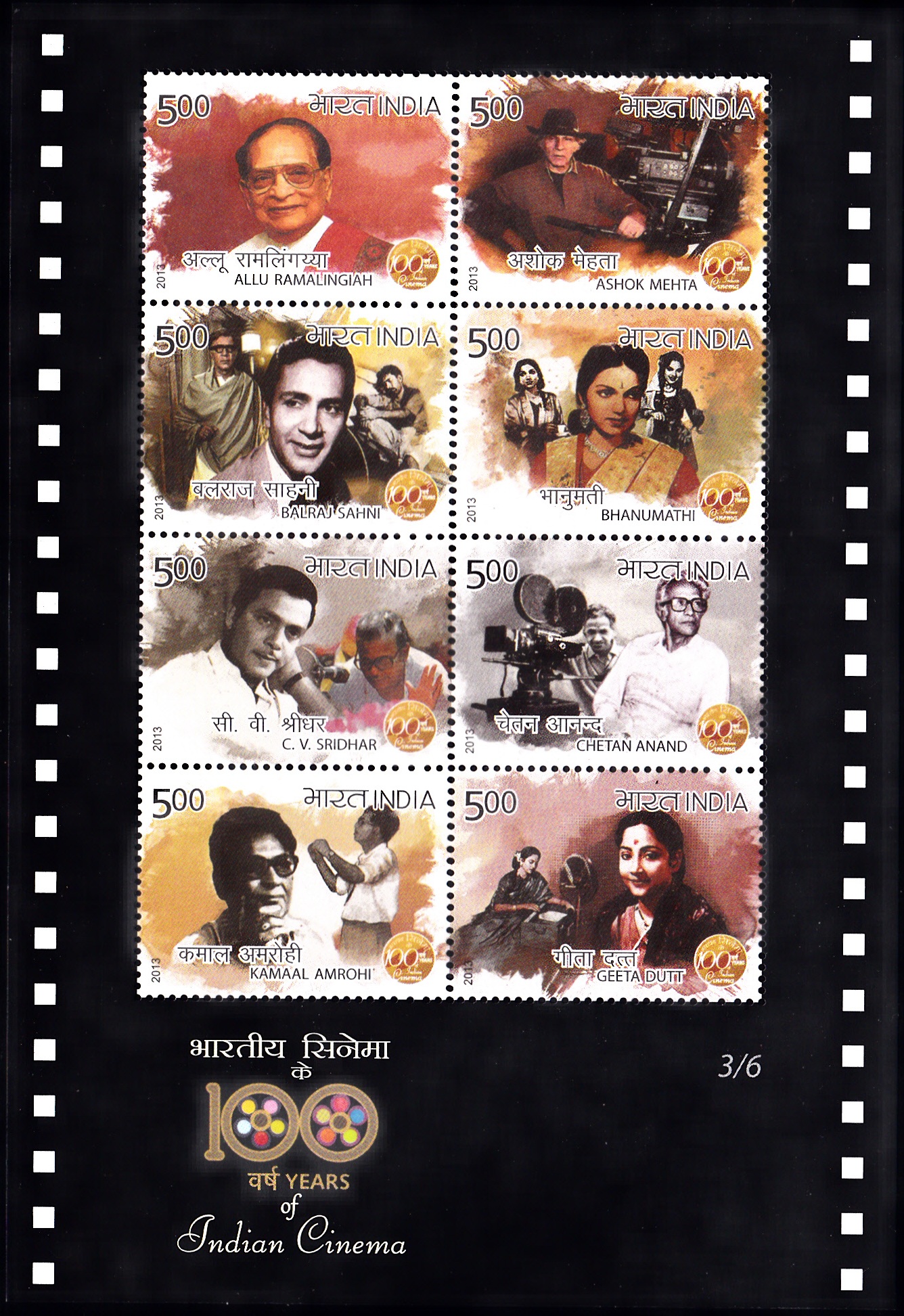
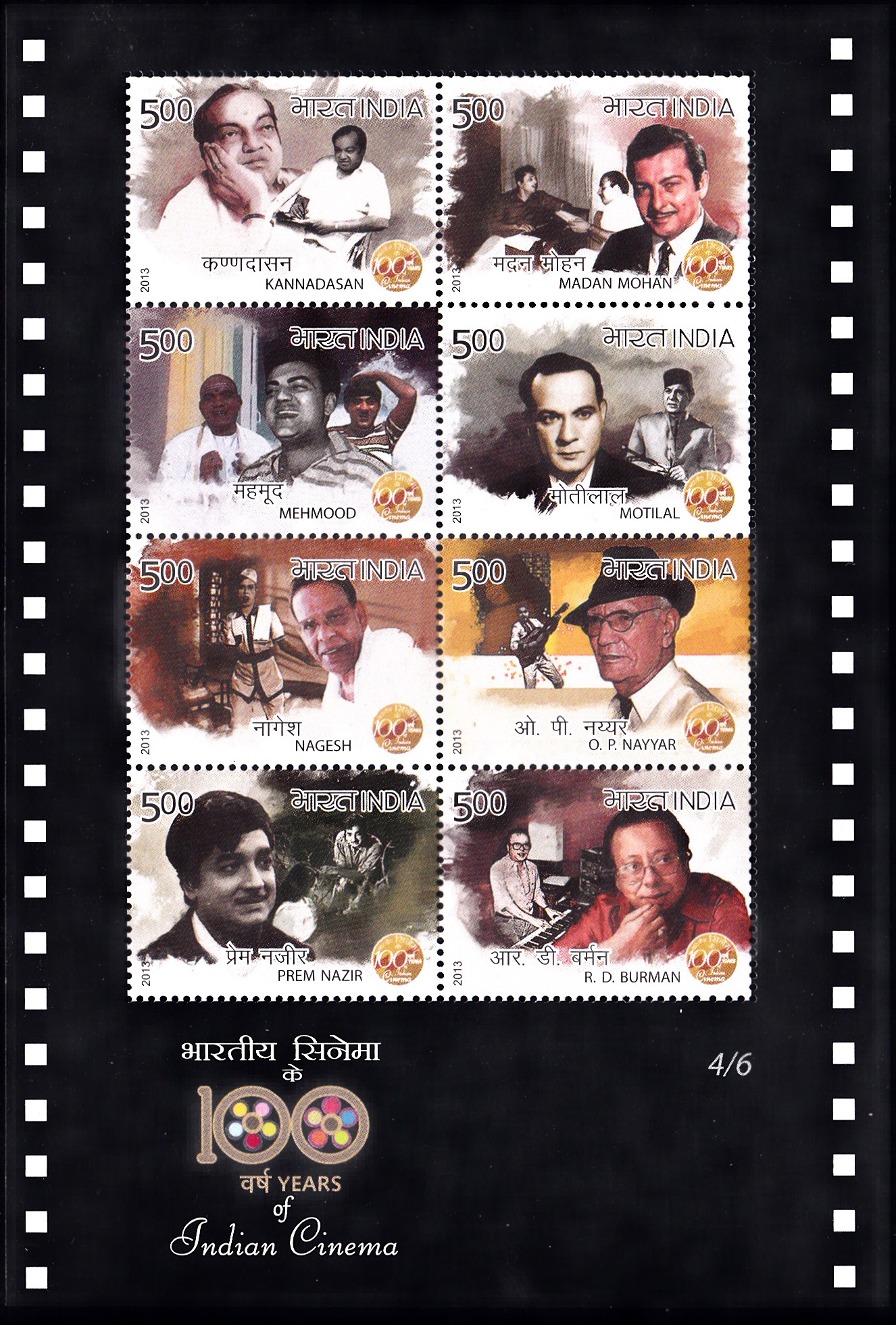


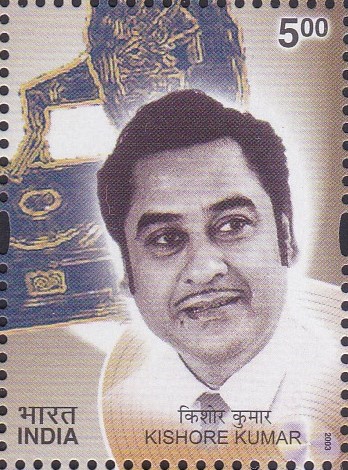
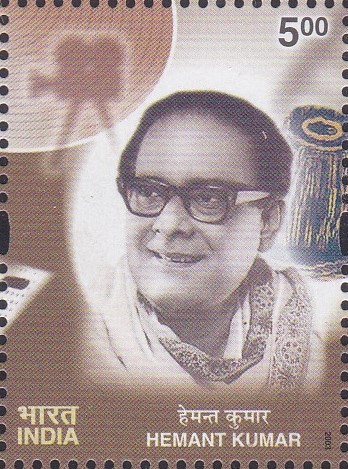
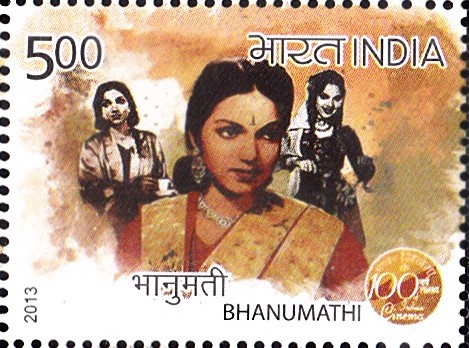

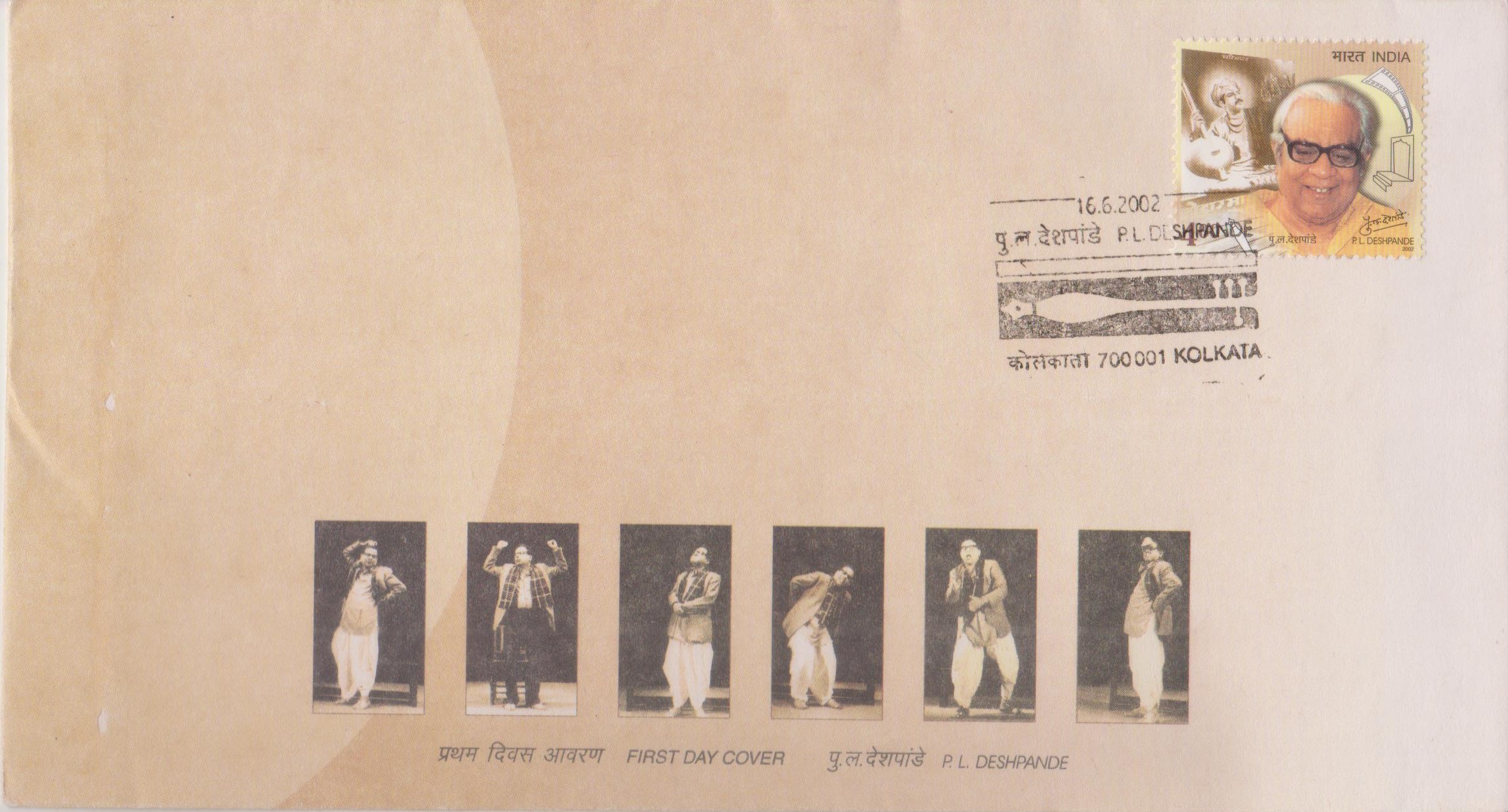
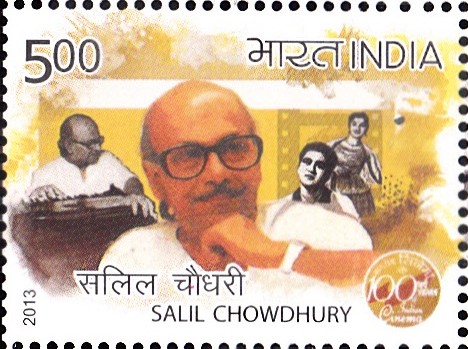
TRIMURTI STARS – DILIP – RAJ-DEV ANAND. There is no stamp of Dilip Kumar perhaps he is still alive.
What about the great film makers Guru Dutt & Vijay Anand? Government should have recognised some of the top singers and music directors of Golden Era such as Rafi, Kishore, Mukesh, Hemant & Manna Dey and music director Sachin Dev Burman who has given so many unique hit songs.
there are already stamps issued on all the personalities you have said.
There are LEGENDARY SINGERS OF INDIA 2016 & Guru Dutt stamps but not included in 100 years of Indian Cinema tribute. S.D. Burman and C. Ramchandra have given lots of hit songs and I think that recognition should be given to these late great music directors also.
Sorry for two ligend artist not add 100yrs. Indian cinema : 1. Rajkumar (kulbhusun kharbanda pandit) 2.Sunil Dutta
One and the only classic super star of malayalam cinema ‘Prem Nazeer’included. Thank you.
[…] popularly known as Ghantasala, was one of the most popular playback singers of all time in Indian film industry. He was also an accomplished music […]
[…] Ghatak has come to be regarded as one of the greatest figures in the history of Indian Cinema. Though he made only eight feature and several short films, his brilliant and abrasive films are […]
[…] prominent singer in the Hindi film industry who found particular prominence as a playback singer in Hindi cinema. She also sang many Bengali songs. She got her first break in 1946, in the mythological film Bhakta […]
[…] more often than not, is the trendsetter in Indian fashion. Devika Rani was the first lady of Indian Cinema who took the position of Indian Cinema to global standards. Her attire, both in films and sometimes […]